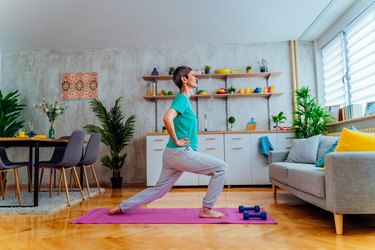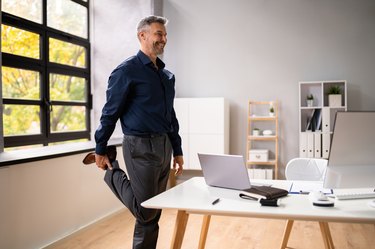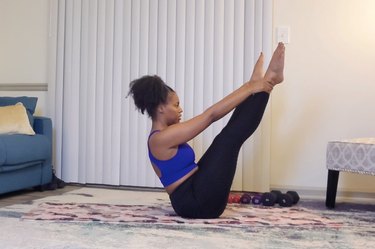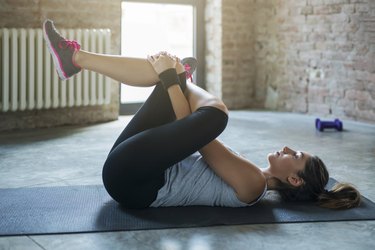

Did you spend hours joy riding on your kick scooter as a kid? While you were probably focused on the fun of zipping along the sidewalk, scooting was also stellar for shoring up skills like balance and coordination (think: You need stability to stand on one leg and kick the other at the same time).
This scooting movement is the basis for an excellent exercise called the Pilates scooter lunge. The body-weight move — which involves standing stationary on a single leg while "scooting" the other behind you — boasts a bevy of benefits for longevity. Not only does it build balance and body awareness, but it also strengthens your glutes and lubricates your knee joints.
Video of the Day
Ready to start scooting? While this exercise doesn't require an actual kick scooter, it's just as fun and can help you glide into your golden years with grace.
How to Do the Pilates Scooter Lunge
Since the scooter lunge is a low-impact body-weight movement, it's suitable for all fitness levels. Still, just because it's simple, it doesn't mean it's easy — prepare to feel the burn in your booty.
Here, Grayson Wickham, DPT, CSCS, a certified strength and conditioning specialist, physical therapist and founder of the Movement Vault, demonstrates how to do the Pilates scooter lunge. Aim to do the scooter lunge two to three times per week as part of your regular strength-training workouts.
- Start in a slight lunge position with your left leg forward.
- Keep your left knee tracking over the middle of your foot, just behind the toes. Don’t let your knee buckle inward or outward.
- Engage your core by pulling your ribcage downward and tuck your tailbone underneath. This will keep all your midsection muscles activated and help you avoid arching your low back.
- Hinge at your hips and root all your weight through your front (left) foot to engage your glutes and quads.
- Slowly extend your right leg behind you and reach your foot backward, then bring it forward, lightly tapping it next to your front leg, still maintaining all your weight on the left foot.
- Continue for desired reps, then switch legs and repeat on the other side.
Why the Scooter Lunge Is Great for Healthy Aging
1. It Builds Balance
Since balance declines with age, it's important to incorporate exercises into your regular routine that support your ability to stay steady on your feet.
"The scooter lunge is a great exercise to work on improving your single-leg balance," Wickham says.
That's because it involves balancing on one leg and keeping your trunk upright as you skillfully move the other limb.
"Improving your single-leg balance will carry over to almost any movement you perform with your lower body including running, squats, lunges, cleans, deadlifts and any sport you can think of," Wickham says.
Not to mention, you need balance for everyday activities (read: scaling the stairs, getting in and out of a car, stepping over a puddle, etc.). While you may not think too much about these mundane physical tasks in your younger years, being able to perform them later in life will be crucial to maintaining independence.
What's more, "single-leg balance is also very important when it comes to decreasing injury risk, specifically your risk of falling," Wickham says.
Unfortunately, falls happen more frequently in older age. A quarter of aging Americans will take a spill every year, and a fifth of these falls will cause a serious injury, including broken bones or head trauma, per the Centers for Disease Control and Prevention.
2. It Boosts Glute Strength
The scooter lunge levels up your glute game by strengthening and activating your butt muscles.
Here's why: The scooter lunge is a single-leg isometric hold for the stationary leg, Wickham says.
"An isometric hold happens when you contract muscles around a joint while not moving that specific joint (in this case these joints are the hips, knees and ankles)," Wickham says. "This isometric hold targets your gluteus and quad muscles (as well as your calf muscles due to the angle of your hips and knees) and is an effective way to switch up how your lower body typically works, which can lead to increased glute strength and activation."
And this is beneficial for aging since your bum — the biggest and most powerful muscle in your body — plays a pivotal role in keeping your torso upright, according to the Library of Congress.
That means it's crucial for many movement patterns that require your body to be in an erect posture (think: standing, walking, running, climbing stairs, etc.). And once again, these daily activities are the cornerstone of living independently as you age.
Not to mention, strong gluteus muscles minimize your risk for hip, knee and/or back pain, all of which become more common in one's older years.
3. It Improves Knee Stability
If you want to steer clear of creaky knees, start doing the scooter lunge.
"A big key when it comes to knee stability is having optimal hip and ankle stability," Wickham says. And the scooter lunge — with its focus on lower-body strength and stability — can help you achieve just that.
But why are healthy hips and ankles necessary for sturdy knees? If your hip or ankle isn't stable, "your knee will compensate and be put in compromising positions that can lead to wear and tear, and potentially pain and injury," Wickham says.
And strong, agile knee joints are crucial for healthy aging. Indeed, your knees tend to be injury-prone hotspots for age-related aches and pains like arthritis.
But "when all the connective tissues — including your tendons, ligaments, fascia, quadricep and hamstring muscles — around your knees are strong and resilient, your chances of knee injury decrease significantly," Wickham says.
4. It Promotes Proprioception
"The scooter lunge is also great for improving body awareness, also known as proprioception (sense of your body in space)," Wickham says.
Boosting your body awareness is all about focus and concentration, and the scooter lunge demands both, he says. Think about it like this: It requires a bunch of brain power and careful attention to balance on a single leg while simultaneously working your opposite limb and keeping your torso stationary and stable.
"The better your body awareness is, the better your coordination will be, which means better performance and again, decreased injury risk," Wickham says. Which we can all agree are good things for growing gray gracefully.


